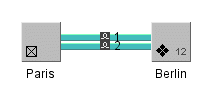Link set class
Link sets are predefined business objects of the class IltLinkSet used to represent a collection
of links between network resources, laid out in a specific order
and with a specific distance.
Link sets let you group together links
between two nodes, so that the graph layout cannot insert a link
that is not in the link set between them or have them follow
different paths. You can fix the order of the links in the set
and specify the distance that separates two links.

Link sets
Note
Link sets can be nested. In other words,
they can include other link sets, which in turn can group a set
of links.
The
IltLinkSet
class does not declare any specific attribute.
You can retrieve the class
IltLinkSet
using its GetIlpClass method. You can handle its
instances as simple IlpObject instances and set and get its
attributes with the generic methods getAttributeValue and setAttributeValue.
Loading a link set defined in XML
This section shows how to load a link set from an XML file in a
data source. For detailed information about data sources, see Data sources.
All you have to do is create a data source using the data source
default implementation defined by IltDefaultDataSource and pass the XML file
to the
parse
method of the data source, as shown below:
dataSource = new IltDefaultDataSource();
dataSource.parse("LinkSetXMLFile.xml");
How to define a link set in XML
The following is an example of a link set defined in XML
format. For details about the XML elements used in this
example, see Elements in an XML data file .
<addObject id="Link1">
<class>ilog.tgo.model.IltLink</class>
<link> <from>Paris</from> <to>Berlin</to> </link>
<attribute name="name">1</attribute>
<attribute name="objectState" javaClass="ilog.tgo.model.IltSONETObjectState">
<state>
Active
</state>
</attribute>
</addObject>
<addObject id="Link2">
<class>ilog.tgo.model.IltLink</class>
<link> <from>Paris</from> <to>Berlin</to> </link>
<attribute name="name">2</attribute>
<attribute name="objectState" javaClass="ilog.tgo.model.IltSONETObjectState">
<state>
Active
</state>
</attribute>
</addObject>
<addObject id="linkSet12">
<class>ilog.tgo.model.IltLinkSet</class>
<link>
<from>Paris</from>
<to>Berlin</to>
</link>
<children>
<child>Link1</child>
<child>Link2</child>
</children>
</addObject>
The figure below shows the link set
displayed in a network component:

Link set displayed in a network
component
Creating a link set with the API
This section shows how to create a link
set through the API and how to add it to a data source.
How to create a link set with the API
IltNetworkElement paris = new IltNetworkElement("Paris",
IltNetworkElement.Type.NE, null);
paris.setFunction(IltNetworkElement.Function.SwitchCrossConnect);
paris.setPosition(new IlpPoint(120, 350));
IltNetworkElement berlin = new IltNetworkElement("Berlin",
IltNetworkElement.Type.NE, null);
berlin.setFunction(IltNetworkElement.Function.TransportCrossConnect);
berlin.setFamily(IltNetworkElement.Family.OC12);
berlin.setPosition(new IlpPoint(250, 350));
IltLink link1 = new IltLink(new IltSONETObjectState(IltSONET.State.Active),
"1", null);
IltLink link2 = new IltLink(new IltSONETObjectState(IltSONET.State.Active),
"2", null);
IltLinkSet linkSet = new IltLinkSet();
List objects = new ArrayList();
objects.add(paris);
objects.add(berlin);
objects.add(link1);
objects.add(link2);
objects.add(linkSet);
dataSource.setLink(link1.getIdentifier(), paris.getIdentifier(),
berlin.getIdentifier());
dataSource.setLink(link2.getIdentifier(), paris.getIdentifier(),
berlin.getIdentifier());
dataSource.setLink(linkSet.getIdentifier(), paris.getIdentifier(),
berlin.getIdentifier());
dataSource.setParent(link1.getIdentifier(), linkSet.getIdentifier());
dataSource.setParent(link2.getIdentifier(), linkSet.getIdentifier());
dataSource.addObjects(objects);
The result looks like this:

Link set displayed in a network
component